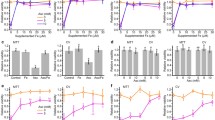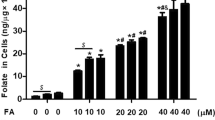Abstract
Ascorbic acid at pharmacologically attainable concentrations effectively inhibited the growth of the catecholamine-positive neuroblastoma cell line SK-N-SH; it inhibited LS cells to a smaller extent and catecholamine-negative SK-N-LO cell growth least effectively. In all three cell lines high concentrations of H2O2 were found. Since ascorbic acid was shown to release iron from ferritin in vitro and to keep it in the reduced state, we suggested that it acted as a pro-oxidant in ferritin-rich neuroblastoma cells in the presence of H2O2 and Fe2+ (Fenton reaction), implying iron release from cellular ferritin. We show here that iron could be mobilized from cellular ferritin by 1 mM ascorbic acid in iron-59-preloaded SK-N-SH and LS cells, but not in SK-N-LO cells. In agreement with these results, DNA strand break formation by ascorbate was only observed in SK-N-SH and LS cells. In SK-N-LO cells, DNA strand breaks could be induced by a combination of 1 mM ascorbic acid and 100 μM H2O2. Since cell-damaging effects caused by chemotherapy further facilitate iron release from ferritin, we conclude that ascorbate could be a powerful enhancer of some cytostatic drugs in neuroblastoma therapy.
Similar content being viewed by others
Abbreviations
- ECL:
-
enhanced chemoluminescence
- MTT:
-
3-(4,5-dimethylthiazol-2-yl)-2,5-diphenyltetrazolium bromide
- PBS:
-
phosphatebuffered saline
References
Baader SL, Bruchelt G, Handgretinger R, Niethammer D (1992) A simple assay for determination of iron release from ferritin in neuroblastoma cells. J Biochem Biophys Methods 25:11–15
Biedler JL, Helson L, Spengler BA (1973) Morphology and growth, tumorigenicity and cytogenetics of human neuroblastoma cells in continuous culture. Cancer Res 33:264–2652
Birnboim HC, Jeveak JJ (1981) Fluorimetric method for rapid detection of DNA strand breaks in human white blood cells produced by low dose radiation. Cancer Res 41:1889–1892
Boyer RF, McCleary CJ (1987) Superoxide ion as a primary reductant in ascorbate-mediated ferritin iron release. Free Radical Biol Med 3:389–395
Bruchelt G, Schraufstaetter IU, Niethammer D, Cochrane CG (1991) Ascorbic acid enhances the effects of 6-hydroxydopamine and H2O2 on iron-dependent DNA strand breaks and related processes in the neuroblastoma cell line SK-N-SH. Cancer Res 51:6066–6072
Buettner GR (1988) In the absence of catalytic metals ascorbate does not autoxidize at pH 7: ascorbate as a test for catalytic metals. J Biochem Biophys Methods 16:27–40
Carter RL, Hall JM, Corbett RP (1991) Immunohistochemical staining for ferritin in neuroblastomas. Histopathology 18:465–468
Cochrane CG (1991) Cellular injury by oxidants. Am J Med 91:3C-23S–3C-30S
Fenton HJH (1894) Oxidation of tartaric acid in the presence of iron. J Chem Soc 65:899
Gordeuk VR, Brittenham GM (1992) Bleomycin-reactive iron in patients with acute non-lymphocytic leukemia. FEBS Lett 308:4–6.
Halliwell B, Gutteridge JMC (1989) Free radicals in biology and medicine. Oxford University Press, New York.
Halliwell B, Aruoma OI, Mufti G, Bomford A (1988) Bleomycin-detectable iron in serum from leukemic patients before and after chemotherapy-therapeutic implications for treatment with oxidantgenerating drugs. FEBS Lett 241:202–204
Helson L, Helson C, Majeranowski A, Johson G, Tragonos F (1982) Plasma DOPA, DOPA sulfate and neuroblastoma. In: Raybaud C (ed) Proceedings of the XIII Meeting of the International Society for Pediatric Oncology, Marseille, 15–19, September, Excerpta Medica, Amsterdam, pp 110–114
Iancu TC, Shilo H, Kedar A (1988) Neuroblastoma contain iron-rich ferritin. Cancer 61:2497–2502
Iwasa Y, Aida K, Yokomori N, Inoue M, Onaya T (1990) Transcriptional regulation of ferritin heavy chain messenger RNA expression by thyroid hormone. Biochem Biophys Res Commun 167:1279–1285
Lode HN, Bruchelt G, Rieth AG, Niethammer D (1990) Release of iron from ferritin by 6-hydroxydopamine under aerobic and anaerobic conditions. Free Radical Res Commun 11:153–158
Loeb LA, James EA, Waltersdorph AM, Klebanoff SJ (1988) Mutagenesis by the autoxidation of iron with isolated DNA. Proc Natl Acad Sci USA 85:3918–3922
Mattia E, Den Blaauwen J, Van Renswoude J (1990) Role of protein synthesis in the accumulation of ferritin messenger RNA during exposure of cells to iron. Biochem J 267:553–555
Miller DM, Aust SD (1989) Studies of ascorbate-dependent, iron-catalyzed lipid peroxidation. Arch Biochem Biophys 271:113–119
Monteiro HP, Winterbourn CC (1989) 6-Hydroxydopamine releases iron from ferritin and promotes ferritin-dependent lipid peroxidation. Biochem Pharmacol 38:4177–4182
Mosmann T (1983) Rapid colorimetric assay for cellular growth and survival: application to proliferation and cytotoxicity assay. J Immunol Methods 65:55–63
Pavelic K (1985) L-ascorbic acid-induced DNA strand breaks and cross links in human neuroblastoma cells. Brain Res 342:369–373
Prasad KN, Sinha PK, Ramanujam M, Sakamoto A (1979) Sodium ascorbate potentiates the growth inhibitory effects of certain agents on neuroblastoma cells in culture. Proc Natl Acad Sci USA 76:829–832
Reif DW (1992) Ferritin as a source of iron for oxidative damage. Free Radical Biol Med 12:417–427
Rieth AG, Baader SL, Lode HN, Bruchelt G, Niethammer D (1992) Ferritin enhances production of DNA strand breaks by 6-hydroxydopamine, ascorbic acid and H2O2 in CCC PM2 bacteriophage DNA. Biometals 5:223–227
Rudolph G, Schilbach-Stueckle K, Handgretinger R, Kaiser P, Hameister H (1991) Cytogenetic and molecular characterization of a newly established neuroblastoma cell line LS. Human Genet 86:562–566
Schneider JE, Browning MM, Floyd RA (1988) Ascorbate/iron mediation of hydroxyl free radical damage to pBR322 plasmid DNA. Free Radic Biol Med 5:287–295
Schneider JE, Browning MM, Zhu X, Eneff KL, Floyd RA (1989) Characterization of hydroxyl free radical mediated damage to plasmid pBR322 DNA. Mutat Res 9 (214):23–31
Schraufstaetter IU, Hyslop PA, Jackson JH, Cochrane CG (1988a) Oxidant-induced DNA damage of target cells. J Clin Invest 82:1040–1050.
Schraufstaetter IU, Hasley WA, Hyslop PA, Cochrane CG (1988b) In vitro models for the study of oxidant-induced injury of cells in inflammation. Methods Enzymol 163:328–339
Senoh S, Witkop B, Crevelling CR, Udenfriend S (1959) 2,4,5-Trihydroxyphenetylamine, a new metabolite of 3,4-dihydroxyphenetylamine. J Am Chem Soc 81:1786–1769
Slivka A, Cohen G (1985) Hydroxyl radical attack on dopamine. J Biol Chem 260:15466–15472
Smets A, Lösberg C, Janssen M, Metwally AM, Huiscamp R (1989) Active uptake and extravesicular storage of m-iodobenzylguanidine in human neuroblastoma SK-N-SH cells. Cancer Res 49:2941–2944
Szatrowski TP, Nathan CF (1991) Production of large amounts of hydrogen peroxide by human tumor cells. Cancer Res 51:794–798
Author information
Authors and Affiliations
Additional information
Supported by the Deutsche Krebshilfe, grant W54/89/Ni4
Rights and permissions
About this article
Cite this article
Baader, S.L., Bruchelt, G., Carmine, T.C. et al. Ascorbic-acid-mediated iron release from cellular ferritin and its relation to the formation of DNA strand breaks in neuroblastoma cells. J Cancer Res Clin Oncol 120, 415–421 (1994). https://doi.org/10.1007/BF01240141
Received:
Accepted:
Issue Date:
DOI: https://doi.org/10.1007/BF01240141




